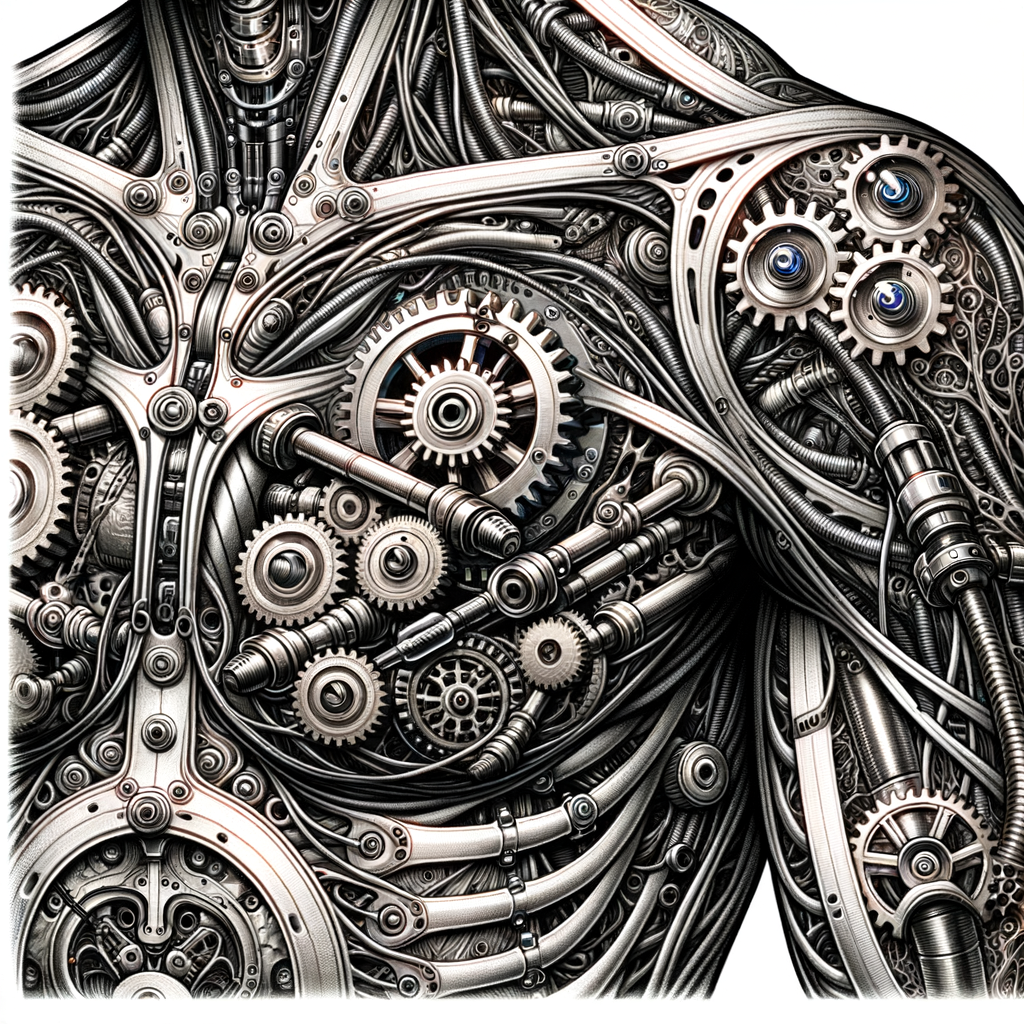
Introduction to Biomechanical Tattoo Art
Welcome to the world of Biomechanical Tattoo Art, a unique fusion of creativity, science, and human anatomy. This art form is not just about creating stunning visuals on the skin, but it also reflects a deep understanding of the human body and its mechanics. Let’s dive in to explore more about this fascinating art form.
- Definition of Biomechanical Tattoo Art
- History and Evolution of Biomechanical Tattoo Art
- Impact of Science in Tattoos
Biomechanical Tattoo Art is a unique style of tattoos that combines elements of machinery and robotics with the human body. These tattoos often depict the body as a complex machine, with gears, wires, and metal plates replacing flesh and bone. The result is a stunning visual that blurs the line between man and machine.
Biomechanical Tattoo Art has its roots in the late 1970s and early 1980s, when artists began experimenting with new styles and themes. Inspired by science fiction and the growing interest in robotics, these artists created a new genre that combined the human form with mechanical elements. Over the years, this art form has evolved, with artists now using 3D techniques to create tattoos that look like they’re part of the wearer’s body.
Science has had a significant impact on the world of tattoos, particularly in the realm of Biomechanical Tattoo Art. Advances in technology have allowed artists to create more detailed and realistic designs, while an understanding of human anatomy helps them create tattoos that work with the body’s natural movements. Furthermore, developments in tattoo inks and equipment have made it possible to create tattoos with a wider range of colors and effects.
In conclusion, Biomechanical Tattoo Art is a fascinating blend of art and science, creating stunning visuals that challenge our perceptions of the human body. Whether you’re a fan of tattoos or simply interested in the intersection of art and science, there’s no denying the appeal of this unique art form.
The Intersection of Art and Science in Tattoos
When we think of tattoos, we often picture intricate designs and vibrant colors. But have you ever considered the science behind these stunning works of body art? Let’s delve into the fascinating world of science-inspired tattoos and explore how scientific concepts influence tattoo designs.
Science Inspired Tattoos
Science and tattoos may seem like an unlikely pairing, but many tattoo enthusiasts and artists are drawn to the beauty and complexity of scientific concepts. These tattoos can range from simple representations of scientific symbols to intricate designs inspired by complex theories and phenomena.
- Examples of Science Inspired Tattoos
- How Science Influences Tattoo Designs
Science-inspired tattoos come in a myriad of designs. Some people choose to ink their bodies with the chemical structure of a molecule that holds personal significance, such as serotonin, the “happiness” hormone. Others may opt for a stunning representation of a galaxy or a DNA helix. There are also tattoos that pay homage to iconic scientists or groundbreaking scientific discoveries.
Science influences tattoo designs in various ways. For instance, the precise lines and angles in geometric tattoos can be traced back to mathematical principles. The vibrant colors in a galaxy tattoo, on the other hand, are inspired by images captured by space telescopes. Even the process of tattooing itself is a scientific marvel, involving the careful insertion of ink into the dermis layer of the skin.
Whether it’s a simple atom symbol or an intricate depiction of a black hole, science-inspired tattoos are a testament to the beauty of knowledge and discovery. They serve as a permanent reminder of our quest for understanding and our awe at the wonders of the universe.
Artistic Tattoo Techniques
When it comes to the world of tattoos, there are a variety of artistic techniques that artists use to create stunning designs. Let’s explore some of these techniques and understand how they influence the final tattoo designs.
- Traditional Tattoo Techniques
- Modern Tattoo Techniques
- How Art Techniques Influence Tattoo Designs
Traditional tattooing, also known as “Old School”, is characterized by bold lines and bright colors. This technique often includes designs like roses, skulls, and anchors. Traditional tattooing has its roots in the early days of tattooing, when artists had to work with limited tools and pigments. Despite the evolution of tattooing techniques, the charm of traditional tattoos remains timeless.
Modern tattoo techniques have evolved with the advent of new tools and technologies. Artists now have the freedom to experiment with a wide range of styles. Realism, watercolor, and geometric are some popular modern tattoo styles. Realism involves creating tattoos that look as real as possible, while watercolor tattoos mimic the look of a watercolor painting. Geometric tattoos, on the other hand, involve intricate patterns and shapes.
Art techniques greatly influence tattoo designs. For instance, the shading techniques used in traditional painting can be seen in realism tattoos. Similarly, the use of bold lines and bright colors in pop art can be seen in new school tattoos. Understanding different art techniques can help you appreciate the complexity and beauty of different tattoo styles.
In conclusion, the world of tattooing is vast and diverse, with a range of techniques that artists use to create unique designs. Whether it’s the bold and bright designs of traditional tattoos or the intricate patterns of geometric tattoos, there’s a style to suit everyone’s taste.
Exploring Biomechanical Tattoo Designs
Biomechanical tattoos are a unique blend of art and science, creating a captivating visual experience. Let’s delve deeper into understanding the essence of this art form.
Understanding Biomechanical Artwork
Biomechanical artwork is a fascinating genre that combines elements of biology and mechanics. This style of art often depicts human or animal anatomy intertwined with mechanical components, creating a surreal, futuristic image.
- Key Elements of Biomechanical Artwork
- How Biomechanical Artwork Translates into Tattoos
The primary elements of biomechanical artwork include a detailed representation of biological structures such as bones, muscles, and veins, combined with mechanical elements like gears, wires, and metal plates. The artwork often has a 3D effect, giving the illusion of these components existing beneath the skin.
Translating biomechanical artwork into tattoos requires a high level of skill and precision. The tattoo artist must be adept at creating the illusion of depth and texture, making the tattoo appear as if it’s part of the wearer’s body. The result is a stunning piece of body art that looks like a glimpse into a mechanized anatomy.
Biomechanical tattoos are not just about aesthetics; they also represent a unique perspective on the fusion of nature and technology. The wearer often sees it as a symbol of their connection with the evolving world of science and technology.
Innovative Tattoo Designs
As we continue to explore the realm of biomechanical tattoo designs, it’s important to highlight the role of innovation in shaping this unique art form. Let’s delve into some of the most innovative designs and understand how creativity and technology are merging to redefine tattoo art.
- Case Study: Innovative Biomechanical Tattoo Designs
- How Innovation Shapes Tattoo Art
Consider the case of an artist who has taken the concept of biomechanical tattoos to a whole new level. This artist uses a combination of organic and mechanical elements to create a 3D effect, making the tattoo seem like it’s a part of the wearer’s body. The designs often feature gears, wires, and metallic parts intertwined with muscles and bones, creating a surreal effect that is both captivating and thought-provoking.
One of the artist’s most innovative designs is a tattoo that appears to show the wearer’s arm transforming into a robotic limb. The intricate details, shading, and use of color make the design come alive, creating an illusion of movement and depth. This design is a testament to the artist’s creativity and technical skill, and it showcases the potential of biomechanical tattoos to push the boundaries of traditional tattoo art.
Innovation is at the heart of tattoo art. It’s what allows artists to experiment with new designs, techniques, and tools, and it’s what keeps the art form evolving and growing. In the case of biomechanical tattoos, innovation has allowed artists to create designs that were once thought impossible.
For instance, the use of 3D effects in tattoo art is a relatively new development that has been made possible by advances in tattooing techniques and equipment. This innovation has opened up a whole new world of possibilities for tattoo artists and enthusiasts, allowing for the creation of designs that are more realistic and detailed than ever before.
Moreover, the integration of organic and mechanical elements in biomechanical tattoos is another example of how innovation is shaping tattoo art. This unique blend of elements creates a distinct style that is both visually striking and deeply symbolic, reflecting the intersection of nature and technology in our modern world.
The Wonders of Biomechanical Tattoos
Biomechanical tattoos are a marvel of modern artistry, combining the intricacies of human anatomy with the precision of mechanical design. These tattoos are not just skin deep; they are a testament to the wonders of both art and science.
Biomechanical Tattoo Wonders
Biomechanical tattoos are a sight to behold. They push the boundaries of what is possible in tattoo art, creating a fusion of the organic and the mechanical that is both stunning and thought-provoking.
- Examples of Stunning Biomechanical Tattoos
- How Biomechanical Tattoos Push the Boundaries of Art and Science
There are countless examples of stunning biomechanical tattoos. Some depict intricate machinery seemingly embedded within the skin, while others show organic forms intertwined with mechanical components. These designs can range from the subtly intricate to the boldly extravagant, but all share a common thread of awe-inspiring creativity.
Biomechanical tattoos are more than just visually striking; they are a testament to the intersection of art and science. These designs require a deep understanding of both human anatomy and mechanical design, pushing the boundaries of what is possible in tattoo art. The result is a form of body art that is as intellectually stimulating as it is visually impressive.
In conclusion, biomechanical tattoos are a testament to the wonders of both art and science. They push the boundaries of what is possible in tattoo art, creating a fusion of the organic and the mechanical that is both stunning and thought-provoking. Whether you are a fan of body art or simply appreciate the intersection of art and science, there is no denying the marvel that is biomechanical tattoos.
Tattoo Art and Science: A Perfect Blend
When we think of tattoos, we often picture stunning designs and vibrant colors. But there’s more to tattoos than meets the eye. They are a perfect blend of art and science, where creativity meets precision and technique.
- How Tattoo Art and Science Complement Each Other
- Future Trends in Biomechanical Tattoo Art
Tattooing is a process that requires a deep understanding of both art and science. The artist needs to have a keen eye for design and color, but also needs to understand the science behind the skin and how ink interacts with it.
The science part comes into play when the tattoo artist uses a machine to insert the ink into the second layer of the skin, known as the dermis. This layer is stable, ensuring that the tattoo design remains sharp and clear over time. The artist must also understand the body’s immune response, which treats the tattoo ink as a foreign substance and sends white blood cells to try to remove it. However, the ink particles are too large for the cells to fully eliminate, resulting in a permanent tattoo.
On the other hand, the art aspect is evident in the design and execution of the tattoo. The artist uses their creativity and skill to bring a client’s vision to life on their skin. They must consider elements like line, shape, color, and texture to create a visually appealing and meaningful piece.
Biomechanical tattoos, which combine elements of machinery and the human body, are a stunning example of the fusion of art and science. These designs often look like the skin has been peeled back to reveal mechanical parts underneath, creating a captivating 3D effect.
As technology continues to evolve, so too does the world of biomechanical tattoos. One emerging trend is the use of augmented reality (AR) in tattoo design. Artists can use AR to create designs that come to life when viewed through a smartphone or tablet. This adds a whole new level of interactivity and engagement to the tattoo experience.
Another trend is the use of bio-responsive inks, which can change color in response to changes in the body, such as glucose levels or pH balance. This not only creates a dynamic and ever-changing tattoo design but could also serve practical purposes, like helping people with diabetes monitor their blood sugar levels.
Conclusion: The Marvel of Biomechanical Tattoos
As we reach the end of our exploration into the world of biomechanical tattoos, it’s clear that this unique art form is more than just ink on skin. It’s a fusion of creativity and science, a testament to the marvels of technology and the human body. Let’s summarize our key takeaways and look ahead to the future of this fascinating art form.
- Key Takeaways
- Biomechanical tattoos are inspired by elements of science fiction, robotics, and human anatomy.
- The designs are often complex and require a skilled tattoo artist to execute.
- These tattoos can be a form of self-expression, showcasing a love for technology, biology, or the fusion of both.
- Future Perspectives
- Greater use of color and 3D effects to create more lifelike designs.
- Integration of technology into the tattoo process, such as digital mapping of the design on the skin before inking.
- Increased popularity as more people become fascinated by the fusion of biology and technology.
Biomechanical tattoos are a unique blend of art and science, creating designs that mimic the intricacies of our biological and mechanical systems. They offer a new way to express individuality and passion for technology and biology. Here are the main points we’ve learned:
As technology continues to evolve, so too will the art of biomechanical tattoos. With advancements in 3D printing and digital design, we can expect to see even more intricate and realistic designs in the future. Here are some possibilities:
In conclusion, biomechanical tattoos are a testament to the marvels of human creativity and technological advancement. They offer a unique way to express individuality and a passion for the intersection of biology and technology. As we look to the future, there’s no doubt that this art form will continue to evolve and inspire.






